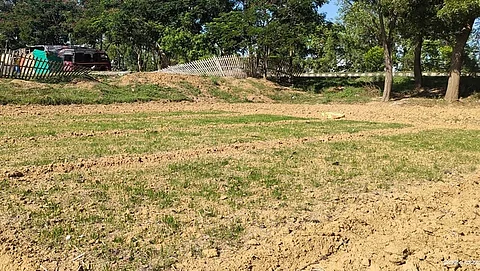

The southwest monsoon continues to be indifferent to Jharkhand. With only 135 millimetres (mm) of rainfall till July 8, 2024 (as compared to a normal 265 mm), the eastern state could well be looking at a third consecutive year of drought if it does not rain soon, farmers have told Down To Earth (DTE).
Most farmers in Jharkhand are dependent on the monsoon for their Kharif crops. Paddy, the main Kharif crop, is usually cultivated in about 1.8 million hectares (mha) in Jharkhand. However, only three per cent of paddy has been sown till now due to the lack of rain.
There has been 60 to 70 per cent less rainfall than normal in the worst-affected districts of Chatra, East Singhbhum, West Singhbhum, Ramgarh, Saraikela Kharsawan, Lohardaga, Pakur and Ramgarh districts.
In most of the districts of Jharkhand, planting usually starts after July 20.
Manoj Prasad, a farmer from Konbegi village in Simdega district, 152 km from state capital Ranchi, was driving a tractor in his field on July 9. He told DTE that there had been good rain for five consecutive days almost a week back. But after, the rain stopped completely.
Gyan Ranjan Singh, a resident of Ormanjhi, 20 km from Ranchi, drives tractors in other farmers’ fields. Every year, he drives at least one of his tractors over 50-60 acres of land for about 100 hours. This year, he has ploughed for barely 30 hours.
To bring more clarity to Gyan Ranjan's words, consider this: Till now, paddy has been planted in only 58,000 hectares of Jharkhand’s 1.8 mha. The crop has been sown in 55,000 of these 58,000 hectares through the ‘sprinkling method’ (Paddy is sprinkled over a ploughed dry field. It gives good yield even in case of less rainfall).
“We still have not lost hope about getting good rains,” Jaiprakash Mandal, a farmer from Basukinath in Deoghar district, told this reporter. Only 10-15 per cent sowing has been carried out in his area.
Mandal stated that the state government had announced drought relief recently. An amount of Rs 3,500 was to be given to every farmer. But barely 60 per cent of farmers have received this money till now.
Jharkhand has not had good monsoons in the last two years.
Last year, only four districts of the state recorded normal rainfall, while 19 districts recorded below normal rainfall. The state government declared 158 blocks of 17 districts as ‘drought affected’.
Paddy was sown in just 0.282 mha, instead of the government target of 1.613 mha, with 1.5 million farmers across Jharkhand affected by the drought.
In 2022, 226 of 260 blocks in 22 districts of the state were declared drought affected.
Pankaj Roy, vice president of the Jharkhand Kisan Mahasabha, told DTE that after three consecutive years of drought, farmers in Jharkhand should seriously consider alternatives to planting paddy.
“Madua (finger millet) holds much greater promise of profit than paddy. The total cost of paddy in one acre, including ploughing, seeds, labour, fertilisers and medicines, comes to Rs 30-32,000. The average production is 25 quintals per acre,” said Roy, who has been working with millets for the past five years. He also runs a start-up named Milllife.
The average price of paddy in the market is Rs 16 to 18 per kg, while the minimum support price (MSP) in Jharkhand is fixed at Rs 23. That means the total income of the farmer per acre is approximately Rs 60,000.
Whereas planting Ragi (another name for Madua or finger millet) costs Rs 10,000 per acre. The production is 10-15 quintals per acre. The MSP of Ragi is Rs 42.90 per kg. The farmer thus earns Rs 40-43,000 per acre.
Ragi, jowar (sorghum), bajra (pearl millet) and chena (proso millet) are mostly grown in Jharkhand as ‘neutral millets’, which have between 3 per cent and 6 per cent fiber content. Ragi (Madua) is produced the most.
Another big problem with paddy, as per experts, is that the crop is harvested in November. But the government starts procuring it after February. Farmers thus are not able to get even the MSP rate.
The farmer sells paddy to brokers at Rs 16-18 per kg. These brokers then sell paddy to the government at MSP rates.
In 2023, the government purchased 6 per cent paddy. Thus, even if the farmer sells directly to the government, the payment is kept pending for two to three years.
Amidst all this, Jharkhand got a new agriculture minister. Congress member of Legislative Assembly Deepika Pandey Singh, who took charge on July 8, said her priority would be to increase the yield of the state’s farmers and double their income. However, her tenure will be barely three months, because elections are likely to be held soon in the state.